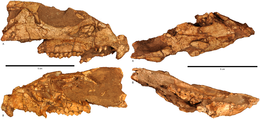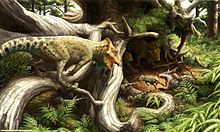Aquilops
| Aquilops | |
|---|---|

| |
| Skull seen from the sides, above, and below | |
| Scientific classification | |
| Domain: | Eukaryota |
| Kingdom: | Animalia |
| Phylum: | Chordata |
| Clade: | Dinosauria |
| Clade: | †Ornithischia |
| Clade: | †Ceratopsia |
| Infraorder: | † Neoceratopsia
|
| Genus: | †Aquilops Farke et al., 2014 |
| Species: | †A. americanus
|
| Binomial name | |
| †Aquilops americanus Farke et al., 2014
| |
Aquilops is an early herbivorous
, approximately 109 million to 104 million years ago. The type species is A. americanus.Description

The skull is 84.2 mm long. The holotype is possibly not from a full-grown individual. A comparison with related species indicates it might have been at 60% of its adult length.[1] Wedel estimated the total body length of Aquilops at 60 cm and its weight at 1.5 kg.[1]
The authors established some unique traits. The rostral, the bone core of the snout beak, curves downwards and has an arched keel on its top with a bump on the front. In front of the tooth row the upper jaw rim is over its total length concave in side view. The skull opening, the antorbital fenestra, is twice as long as it is tall and has a pointed rear, below the eye socket.[1]
Discovery and naming

In 1997,
In 2014 the
The holotype, OMNH 34557, was found in a layer of the Cloverly Formation, dating from the middle-late Albian. It consists of a skull with lower jaws, of a subadult individual. The rear of the head and the palate are the main lacking parts.[1] The specimen was found during a 1997 expedition supported by the National Geographic Society and directed by Cifelli.
Classification



Aquilops was placed in the
| Marginocephalia |
| ||||||||||||||||||||||||||||||||||||||||||
See also
References
- ^ PMID 25494182.
- ^ Crofts, Natalie (2014-12-12). "Utah paleontologist shares tale of discovering cat-sized dinosaur". KSL.com. Salt Lake City: Deseret Digital Media. Retrieved 2014-12-23.
External links
- The Sam Noble Museum - Interactive 3d models of Aquilops skull and dinosaur.
